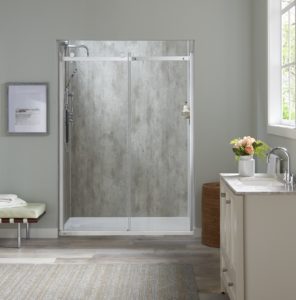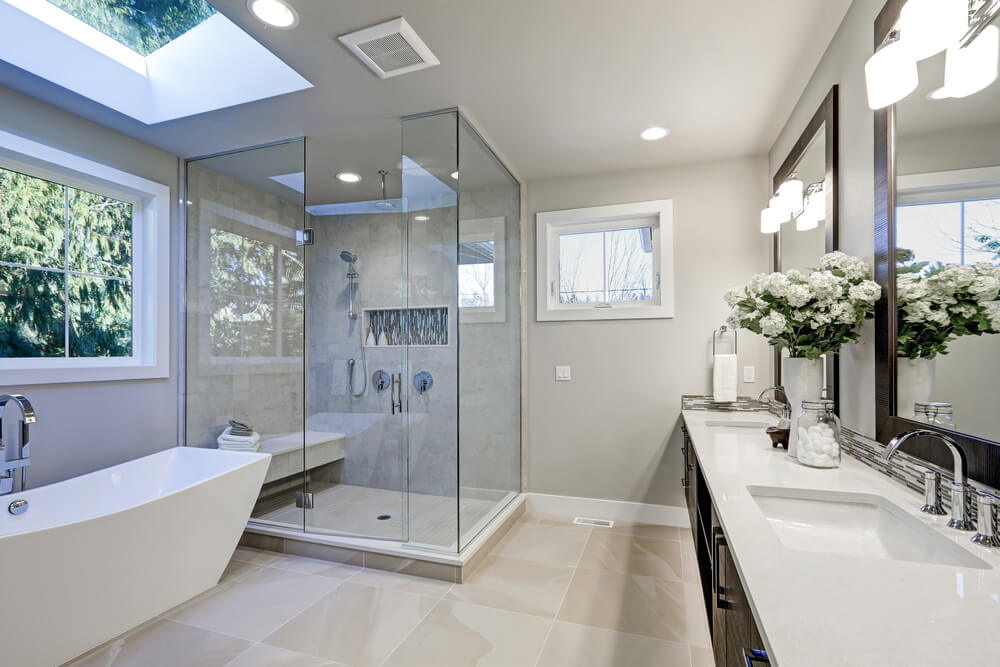What are your ideas on How to Install a Freestand?

A successful shower setup calls for mindful preparation and also a great deal of work. In many cases, you will certainly need to do 3 kinds of tasks: mounting walls, setting up the plumbing, and also completing walls.
Different Sorts Of Shower Units
- Push-on Mixer: The hose pipe as well as spray parts of the push-on mixer shower device can be linked to the bathroom tap according to your requirement, as well as the water temperature can be changed using the faucets. Push-on mixers are cheap as well as exceptionally simple to set up. Nevertheless, although the hose pipe link is easy, it is quickly dislodged. Furthermore, it is inconvenient to change the temperature level.
- Bath/Shower Mixer: The hose and also spray of this kind of shower are incorporated with a bath mixer faucet, and also the temperature level can be adjusted with the bath faucets. It is a very inexpensive option and also no extra plumbing is involved. However, the bath/shower mixers also struggle with bothersome temperature control choices.
- Manual Mixer: The pipe and spray of a hands-on mixer shower device are a part of the wall surface system as well as the hot and cold water products are linked to a single shutoff The temperature and pressure of the water are regulated through either one or a range of knobs (in much more costly showers). Although temperature level control is much easier in hand-operated mixer kinds, they are more pricey than the previously pointed out mixers. They likewise need additional plumbing of cold and hot water pipelines.
- Thermostatic Mixer: The tube and also spray of this shower kind are a part of the wall unit and the cold and hot water supplies are attached to a single valve here too. It is full with a built-in stabiliser to self-adjust the water temperature and to prevent it from coming to be as well warm. Among the largest benefits of a thermostatic mixer shower type includes convenient temperature level control. Nonetheless, it is the most pricey of the different mixer options.
- Power Shower: A power shower is a single device having an effective electric pump that can changing both the water stress as well as temperature level. This kind of shower can be fitted if there is water system from a cold water cistern and a warm water cylinder. A power shower makes the adjustment of both stress and temperature level simple. On the other hand, it disagrees for water heated up straight by the shower or where the water is provided by a mix central heating boiler under mains pressure.
- Electric Shower: An electrical shower is plumbed into a keys cold water supply as well as it heats the water electrically. It is essential to keep in mind that for this shower type to be set up, the keys stress requires to be at the very least 0.7 kg/sq cm (10lb/sq in). The system enables the temperature as well as pressure to be changed using a handle. Versions with temperature level stabilisers are better as they stay unaffected by other faucets elsewhere being used within the home. A significant downside of electrical showers is that the control knob just permits the alternative of heats at much less pressure, or reduced temperature levels at a better stress. This is bothersome in the winter when the spray is typically weak as well as the mains water is cooler. However, this issue is dealt with in some models which are offered with a winter/summer setting.
The Majority Of Typical Mistakes
- Violating or ignoring regional code restrictions.
- Making use of pipelines that are as well tiny.
- Attaching copper to galvanized without using a brass or dielectric suitable between both.
- Not making use of tape or pipeline compound at threaded joints.
- Not leveling your components when mounting them.
- Not installing an air gap filling for fixtures.
- Cutting supply stub outs also short to set up the shutoff valves onto after the completed wall is in place.
- Not properly aligning tubes into fittings or quit valves. (Forcing the nut onto the compression ring at an angle when the tubing is at an angle will trigger a leak.).
- When transforming the water back on in your home, constantly run the outside hose shutoff or flush your commodes to bleed dirt as well as air from the lines. This debris can trigger troubles in your sink faucets as well as various other plumbing trim.
Prep work.
First of all, you must decide on the kind of shower that you wish to mount. It is necessary to establish whether the picked shower is capable of dealing with particular systems as well as can regulate a risk-free degree of water via the boiler. Many shower systems nowadays are developed to be flexible to various water pressures (such as stored hot water and also cool keys).
It is likewise important to take into account the water pressure and also the preparation of the piping and also drain for the shower.
Approach.
Depending upon the type of shower you want to install, the shower head have to either be suited order to avoid its contact with the water in the bathroom listed below or the base tray, or it should have a check valve.
Before starting, it is recommended to note the positions of the shower head and control, and to intend the pipe-work involved. Additionally, the drain system to eliminate the waste water will certainly need to be prepared. Both placements of the cord route and also the shower switch will also require to be thought about if an instant or electric shower unit is being set up.
Use the direction overview provided with the shower device to fit the shower control.Before suitable the pipelines that will provide the water to the shower system, it is important to cut off the water supply. In order to protect the pipelines, they ought to be provided a water-proof covering and likewise fitted with isolating shutoffs. The pipelines can then be buried right into the wall as well as smudged over to neaten the overall appearance.
Fit the base tray, shower head, and fittings.
Link the main shower control to the pipes that will certainly be providing the water (This might call for a women screw thread adapter).
Reconnect the water supply and test the pipelines for any kind of leakages, as some may need tightening up.
If you are installing an electric shower, bear in mind to switch off the electrical power supply prior to making any type of electrical links. Once these links have been made (there ought to be assistance within the instruction manual), the power supply can be switched back on.
Adjusting Water Pressure to Fit Your Shower.
The cold water tank can be raised to a greater height (in some cases as little as 150mm (6inches)) by installation a strong wood assistance under it - possibly made up of struts as well as blockboards. If you pick this alternative, the main as well as circulation pipelines will certainly additionally need to be increased to satisfy the new elevation of the tank.
Conversely, a booster pump (a single pump or a dual/twin pump) can be fitted. Whichever type is selected, it has to be connected into the power supply in order to operate.
Piping and Drainage.
It is best to utilize 15mm diameter supply pipelines, as well as make the runs to the shower as brief and also straight as feasible so as to preserve maximum pressure and also minimise warmth loss. Furthermore, by reducing using elbows for pipeline edges, you can decrease the resistance in the flow of the water. You can accomplish this by flexing the pipelines instead.
How Do You Install a Shower? Follow This Guide
Installing a Shower at a Glance
- Tools & Materials: Level, electric drill, caulk, hole saw, cedar shims, shower unit
- Step 1: Drill pilot holes
- Step 2: Prep fixture holes
- Step 3: Move unit into place
- Step 4: Caulk corners and base
- Step 5: Attach door
- Step 6: Install shower pan
Whenever plumbing is involved in a DIY project, people worry about what might go wrong. The truth is that installing a shower isn’t that complicated, and you can save a lot of money by doing it yourself. You shouldn’t need to make any alterations to your plumbing to complete the job, and most of the tools you need will be provided in your new shower kit.
Can I Install a Shower Myself?
Even if you’ve never installed a shower before, you’ll find this to be a project that is perfectly suited for DIYers with a moderate level of experience. Whether you're doing a bathtub conversion or installing a new stall, most of what you need comes in shower kits that you can purchase from a hardware store. The first thing you need to do is determine what type of shower stall you want.
Single-panel stalls are the easiest to install because they come preassembled. All you need to do is put them in place. Multi-panel showers require a few additional steps, but you’ve got more control over the appearance of your unit. Multi-panel units are also much easier to handle if you’re going to do the installation without any help.
Be sure to take all appropriate safety precautions, such as wearing eye protection and gloves. When you’re removing or installing a shower unit, you might kick up debris that could hurt your eyes. You’ll also need to work with equipment that will get extremely hot, so be sure to have safety gloves handy.
Tools and Materials
- 2- to 4-foot level
- Electric drill with a 1/8-inch drill bit
- Caulk
- 2-inch hole saw
- Cedar shims
- The unit itself
Before You Begin: Prep the Space
It’s highly important to measure your space accurately before putting the stall in. Measuring from the floor upward and from each corner outward will ensure you’ve got the right measurements. What you’re looking for is where the plumbing apparatuses are going to come through the stall. Transfer these measurements over to the back of your unit by drawing the locations of these holes using a pencil or marker.
Pull out your old shower and make sure to scrape off all the old caulking. Be thorough because you want to work with smooth surfaces for the best installation. Once you’ve pulled out your existing shower, you need to make sure that the floor is clean and dry. The best way to clean debris is with a shop vacuum, as it’ll soak up water and dirt together.
If you’re experiencing any plumbing issues, such as low water pressure, this is a perfect opportunity to solve them. Make sure that the pipes themselves are not in need of patching and clean your showerhead. When you turn the water back on after your project, check the pipes for signs of wear or disrepair. Anything beyond minor repairs should be handled by a plumber, and this is the best time to bring in a professional.
If the floor has any moisture at all, don’t proceed until it’s completely dry. The last thing you need is for the floor to rot or invite mold and mildew into your base. Once everything is dry, apply waterproof wallboard to the walls. This can be attached with screws or nails, then sealed with caulk so that water doesn’t seep into any crevices.

Hopefully you enjoyed reading our topic about How to Install a Direct-to-Stud Shower Enclosure. Thanks a lot for taking the time to read our content. If you please take the time to share this blog entry if you enjoyed it. We recognize the value of reading our article about How to Install a Shower Enclosure .
Call
Comments on “Complete Installation Guide for a New Shower Unit”